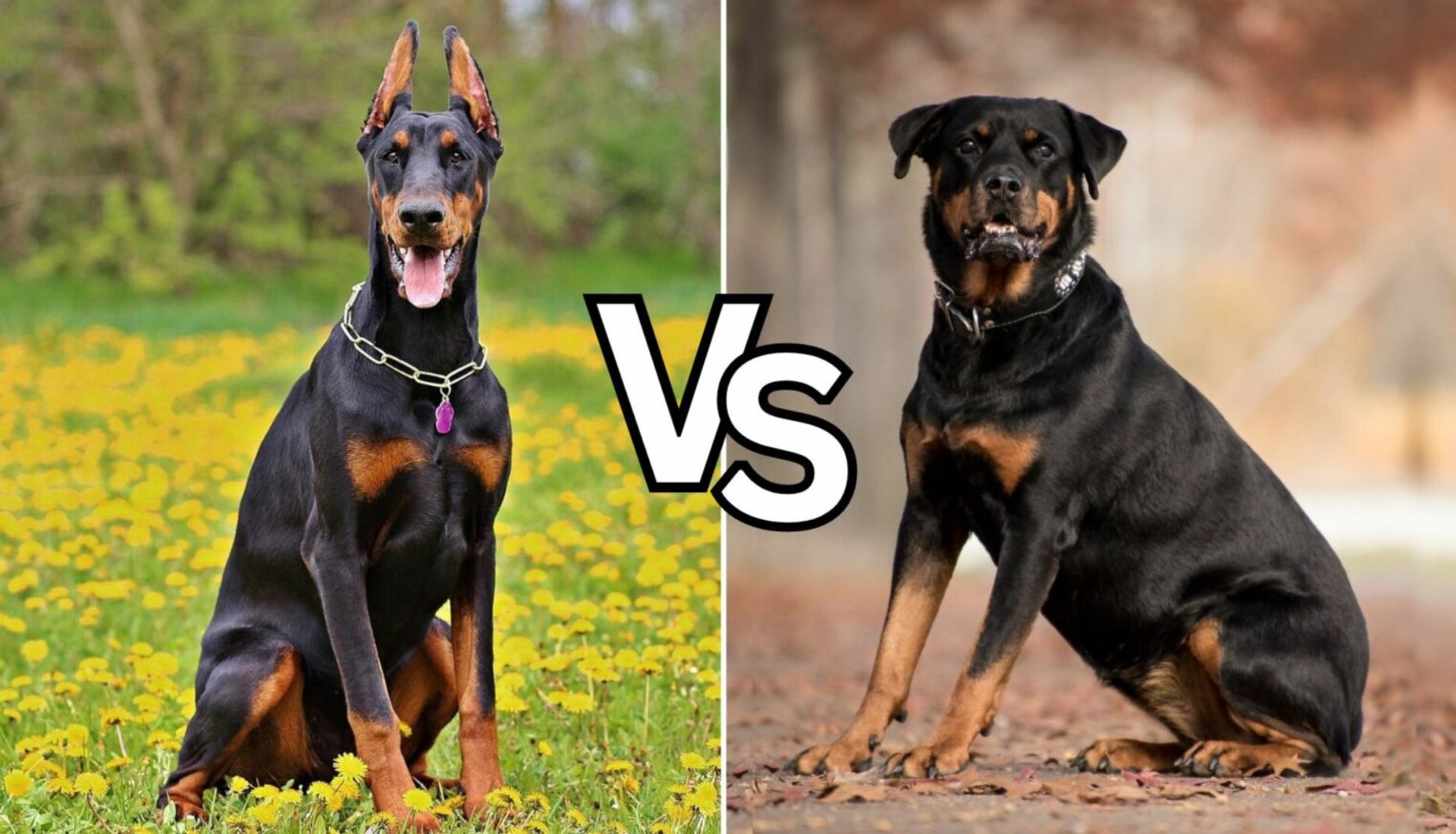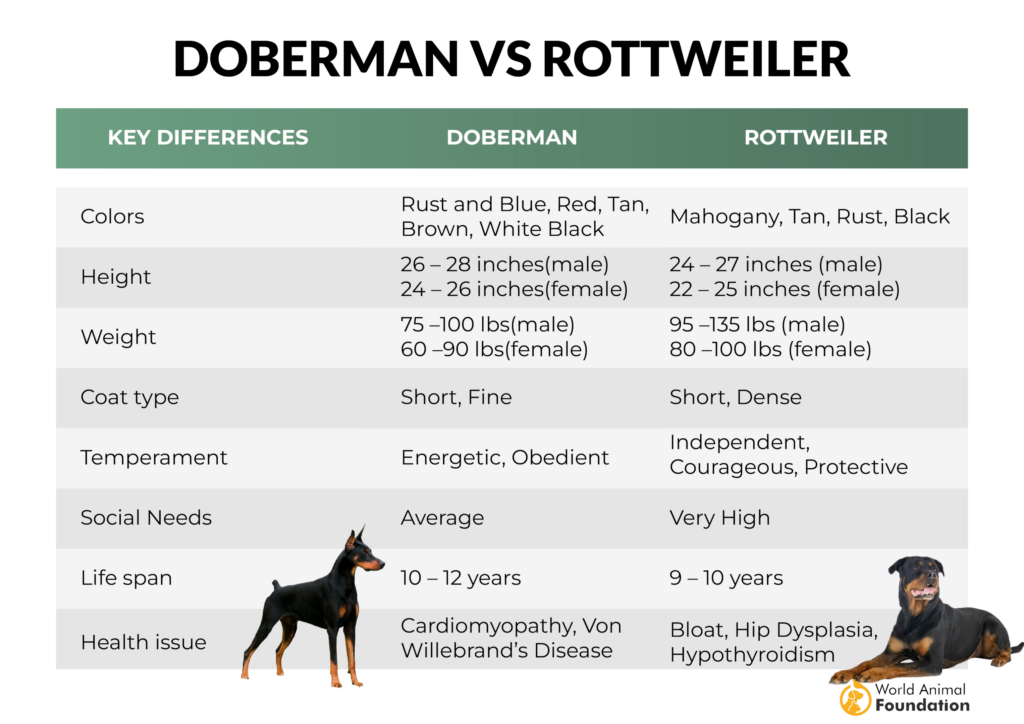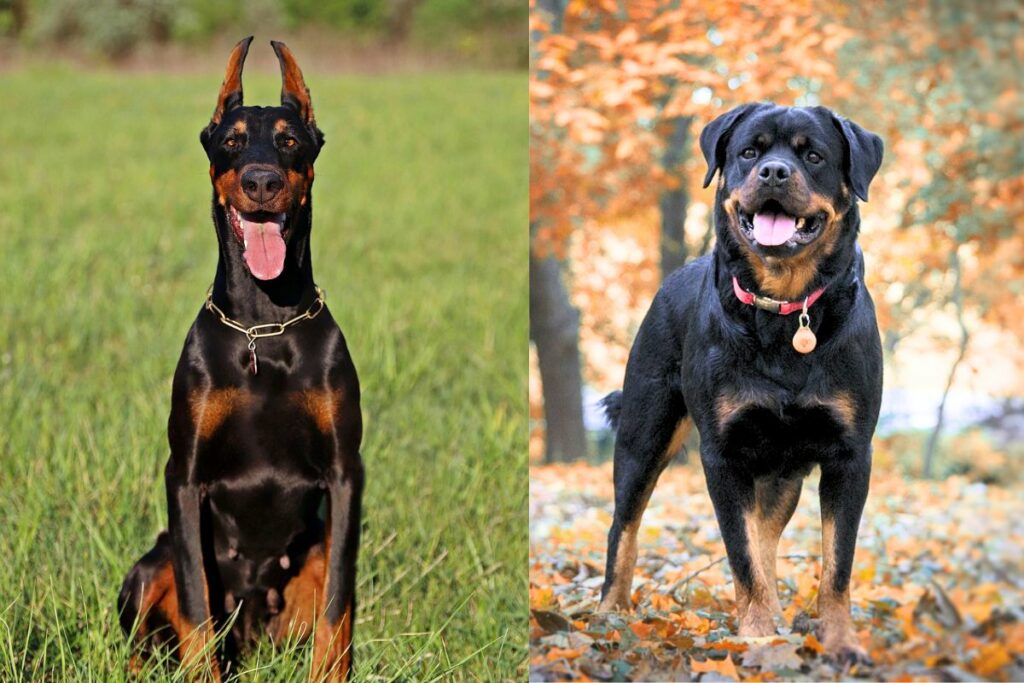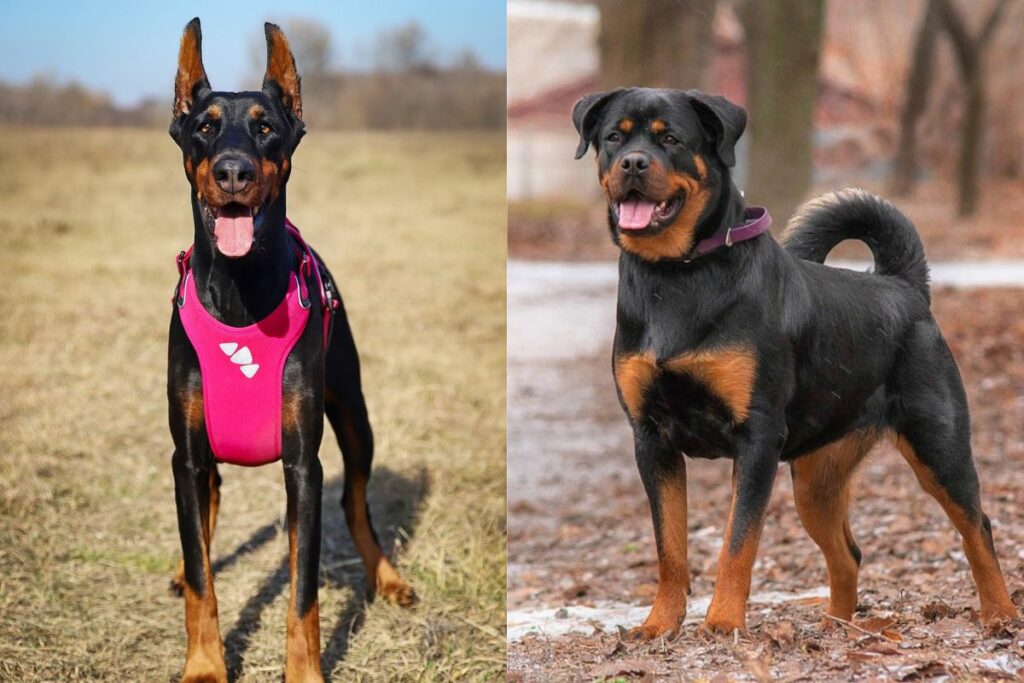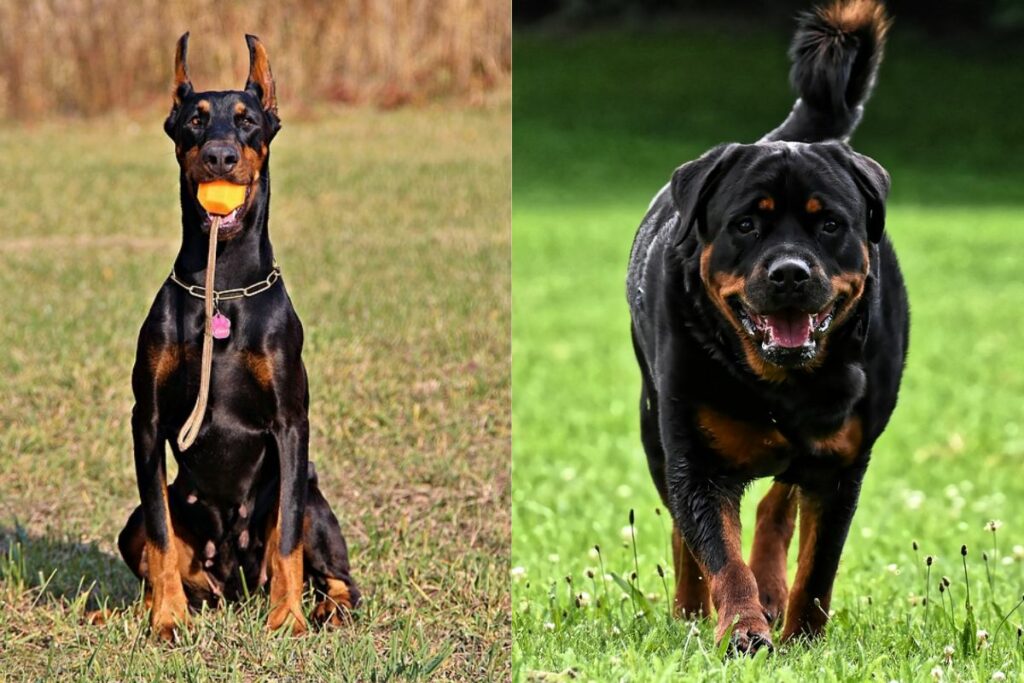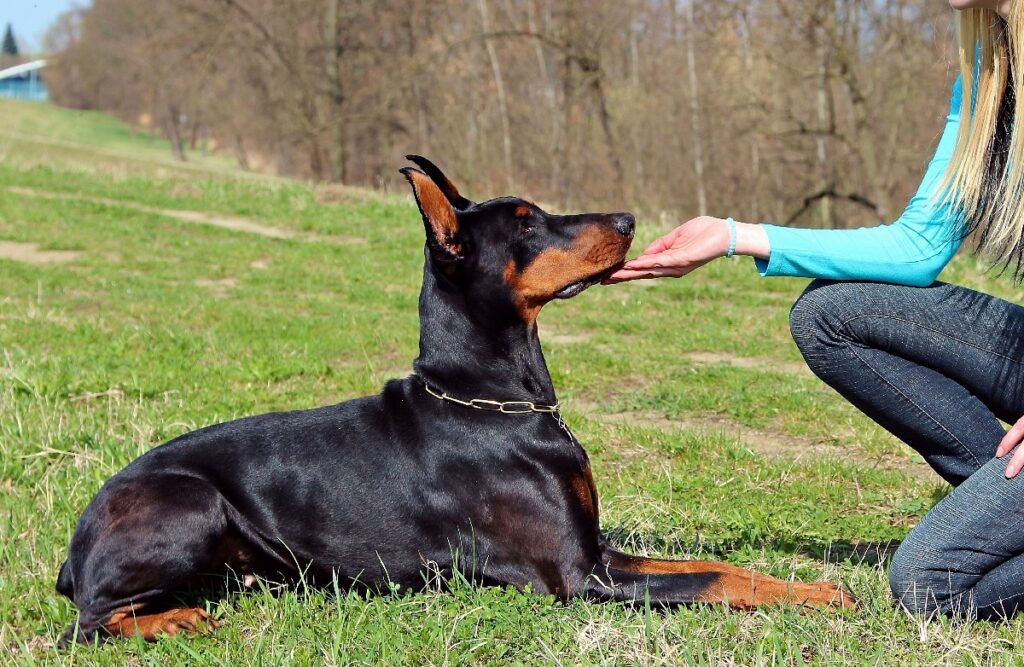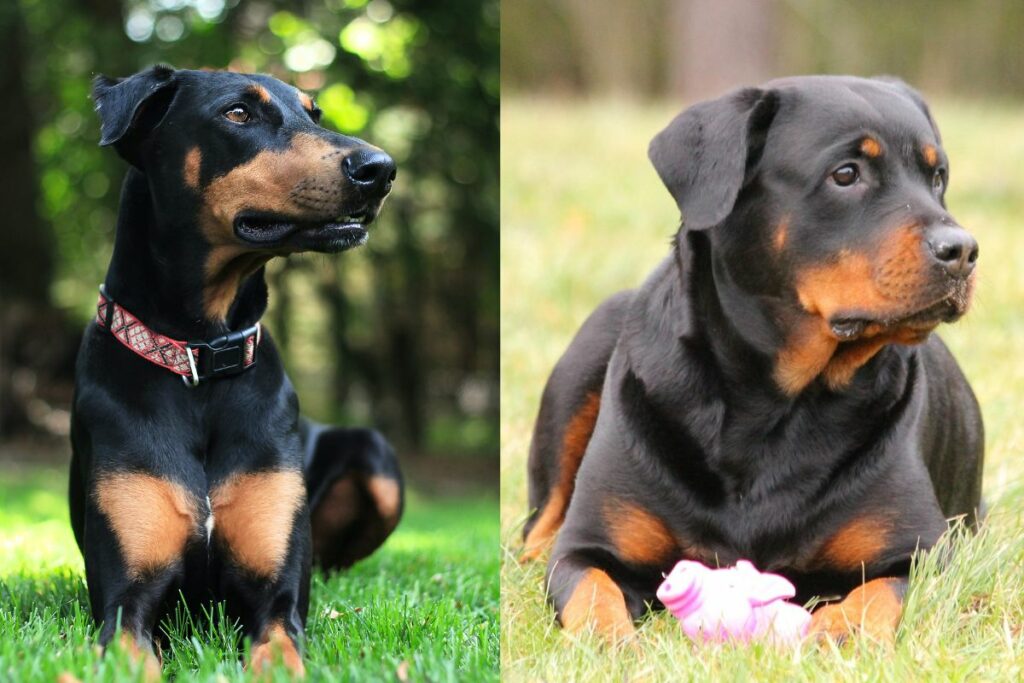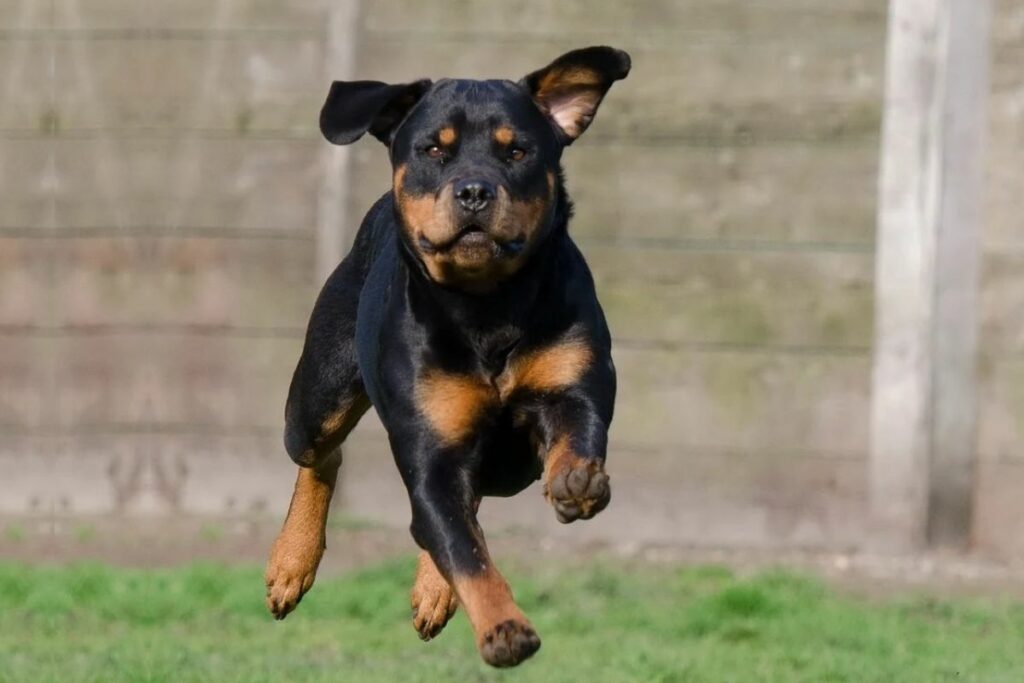Doberman Pinschers and Rottweilers, two iconic German breeds, often top the list for those seeking a loyal protector. But beneath their imposing exteriors lie distinct personalities and needs. This comparison delves into the key differences between these powerful canines, exploring temperament, trainability, exercise requirements, and health concerns. Whether you’re considering adding one of these magnificent breeds to your family or simply curious about their unique qualities, this guide will equip you with the insights needed to appreciate the distinct strengths of both the Doberman and the Rottweiler.
Selecting the perfect canine companion is more than just a choice; it’s a journey to understanding what aligns best with your lifestyle and household. If you find yourself wavering between the majestic Doberman Pinscher and the stalwart Rottweiler, you’re in for an enlightening comparison.
Both breeds are celebrated not just for their iconic status as top-tier guardians but also for their surprisingly affectionate nature, debunking myths of their solely fierce personas.
While the Doberman and Rottweiler share a similar aesthetic—muscular frames and commanding presences—their personalities cater to different family dynamics and needs. This guide is designed to illuminate the unique qualities of each breed, helping you discern which furry friend could be your ideal match.
With a closer look at their temperaments, care needs, and how they blend into family life, we’ll assist you in making a decision that ensures a harmonious addition to your home. Let’s embark on this journey together, unraveling the characteristics that make these breeds remarkable in their own right.
Doberman vs. Rottweiler
Doberman vs. Rottweiler : Origins
The Doberman Pinscher was created by Karl Friedrich Louis Dobermann, a tax collector who needed a protective dog for his dangerous job in the late 19th century. Using his access to various breeds at the local dog pound, Louis combined breeds like the Rottweiler, German Shepherd, German Pinscher, and Great Dane to create the Doberman.
This breed has since been known for its roles as a guard, search & rescue, therapy, and military and police dog.
The Rottweiler dates back to Roman times, originally serving as cattle herders and accompanying armies through Germany. After the Romans, they continued working as herding and excellent guard dogs and even pulled carts. By the early 20th century, the breed nearly vanished as smaller dogs became more popular for the Rottweiler’s jobs.
However, dedicated breeders saved them, making Rottweilers a favored breed in the U.S. today, still working in security and herding in some places.
Doberman vs. Rottweiler: Physical Characteristics
The key difference between Dobermans and Rottweilers lies in their size. Rottweilers are the larger of the two breeds, often classified as large to giant dogs due to their more robust build. On the other hand, Dobermans have a leaner frame, placing them in the medium dog category despite their height.
But size isn’t the only thing that sets these breeds apart. Their personalities and health profiles also show significant distinctions. Let’s dive deeper into what makes each breed unique!
Color
The Doberman Pinscher boasts an impressive array of colors, spanning shades like blue, red, tan, brown, white, and black. Typically, these vibrant hues are complemented by rust-colored markings, adding to their distinctive appearance.
In contrast, the Rottweiler presents a more uniform color scheme, predominantly black with tan to rust-colored markings accentuating their features.
Height
Both the Rottweiler and the Doberman are tall dogs, with the male Rottweiler reaching an average height of 25.5 inches, while the male Doberman typically stands a bit taller at an average of 27 inches.
Weight
While the Doberman typically stands taller, the Rottweiler carries more weight. A fully grown male Rottweiler weighs in at an average of 112 pounds, compared to the Doberman male’s average weight of 93 pounds. Females of both breeds are slightly smaller in size.
Despite the size difference, the Rottweiler’s build can make it appear much larger than the Doberman. Dobermans are known for their speed and muscular build but have a more slender waist and are not as heavy-set as Rottweilers.
In contrast, Rottweilers are solidly built, with a powerful frame, large, broad heads, and flatter muzzles, giving them a distinctly robust appearance.
Coat type
Both the Rottweiler and the Doberman sport short, low-maintenance coats. The Doberman’s coat is smooth and sleek, shedding modestly during seasonal changes, typically twice a year. This means they don’t need much grooming to keep their coat in good condition.
On the other hand, the Rottweiler’s fur is short and a bit rougher, yet like the Doberman, they require minimal grooming.
Doberman vs Rottweiler: Traits
When considering adding a dog to your family, temperament is a crucial factor. Let’s delve into the distinct traits of both the Doberman Pinscher and the Rottweiler to help determine which breed might best match your expectations for a canine companion.
Temperament
Both the Rottweiler and the Doberman are alert, brave, and deeply loyal to their families. Known for their guarding skills, they’re great at protecting their home and sensing danger early.
Rottweilers tend to be more independent and bold, while Dobermans are lively and follow commands well. If you want a cuddly friend, choose a Doberman. For a dog that enjoys being social, a Rottweiler is a better match.
Intelligence
Stanley Coren, a canine psychology expert at the University of British Columbia, authored “The Intelligence of Dogs.” In his ranking of 130 breeds, Dobermans are listed fifth and Rottweilers ninth, placing both in the top 10. Coren’s research suggests
Dobermans have a slight edge in intelligence. However, owning such smart dogs means they require constant stimulation and engagement to stay content.
Behavior With other Pets and People
Before welcoming a new furry friend into your home, it’s crucial to consider how well they’ll blend with your family dynamic.
With the right training and socialization, they are wonderful with children, showcasing a deep loyalty and sometimes an overprotective nature toward their ‘pack.’ Thus, it’s important to ensure both your Doberman and children are well-prepared through proper training to foster a harmonious relationship.
Rottweilers are often misunderstood. These intelligent and loyal dogs have been bred for their guarding instincts for centuries. Their massive size alone commands respect. Primarily working dogs, Rottweilers thrive when given tasks.
A Rottweiler that’s well-trained and socialized is gentle and fun-loving with kids. In the right hands, they quickly become beloved family members.
Social Needs
The Rottweiler is a very social breed that craves attention and can suffer from separation anxiety if left alone too often. In contrast, Dobermans have more moderate social needs and generally cope better with being alone, though they still shouldn’t be left by themselves for too long.
Trainability
Both Dobermans and Rottweilers thrive on mental stimulation and enjoy putting their intelligence to use, making them eager and responsive to training. Their desire to please their owners facilitates a smoother training process, particularly with obedience training.
It’s crucial, however, to establish yourself as the leader; if not, they may try to take on that role themselves.
Given their protective instincts, early socialization is essential to ensure they’re well-adjusted and confident in various settings and comfortable around people of all ages and other animals.
Positive reinforcement is especially effective for these breeds, emphasizing rewards and encouragement over punishment. This approach not only strengthens the bond between dog and owner but also prevents the potential for aggressive behavior, ensuring the training experience is positive for both.
Doberman vs Rottweiler: Health
Let’s look into more details for Dobermans and Rottweilers regarding their life expectancy and health issues.
Life span
Rottweilers typically live between 8 to 11 years, whereas Dobermans have a lifespan of 10 to 12 years. Sadly, Rottweilers can have several health problems that might reduce their lifespan if they’re not well taken care of.
Exercise Needs
Dobermans are high-energy dogs and need 1 to 2 hours of exercise every day to avoid behavioral issues. Activities should be vigorous, like running, swimming, and playing fetch, making them great companions for active people who enjoy outdoor sports.
Rottweilers are a bit more laid-back but still require 45 minutes to 2 hours of daily activity to stay healthy and engaged. They appreciate exercises that challenge their minds as well as their bodies. Games like hide-and-seek, treasure hunts with treats, or navigating through an obstacle course in a secure yard are perfect for keeping a Rottie entertained and fit.
Health Issues
Dobermans and Rottweilers are large breeds that can have health issues like hip and elbow dysplasia, leading to arthritis, and gastric torsion, a dangerous condition where the stomach twists after eating large meals or exercising.
Dobermans may also face Von Willebrand’s disease, which affects blood clotting, while Rottweilers are prone to dilated cardiomyopathy, which weakens the heart. Regular vet visits and staying informed about these health risks can help keep your dog healthy.
Conclusion
When comparing Rottweiler vs Doberman, both breeds stand out as healthy dogs when properly trained and cared for. The American Kennel Club recognizes both as loyal and intelligent large dog breeds.
Dobermans tend to be energetic and require a bit more activity, while Rottweilers bring a calm strength to the table. Both Rottweilers and Doberman Pinschers thrive with early socialization and consistent training.
Ultimately, whether you lean towards a Rottweiler or a Doberman, each breed offers unique qualities that can make for a loving and protective addition to any family, underscoring the importance of understanding the specific needs and characteristics of these distinguished breeds.
Both Doberman Pinschers and Rottweilers are powerful German breeds originally bred for protection, but their temperaments and care needs differ. Dobermans are sleek and athletic, requiring more vigorous exercise, while Rottweilers are stockier and more independent, potentially needing a firmer hand in training. Choosing between the two depends on the owner’s lifestyle and experience. Dobermans suit active owners ready for consistent training and socialization. Rottweilers, while equally intelligent, require experienced owners who can provide confident leadership and manage their protective instincts. Careful consideration of these factors will ensure a harmonious match between breed and owner.

